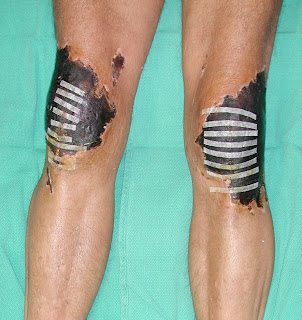



Picture #1: Skin Necrosis after Frostbite from Cryotherapy
Picture #2: After Debridement of Soft Tissues, use of Negative Pressure Dressing
Picture #3: Bilateral Free Flap (Rectus Muscles + Skin Graft) on both Knee Wounds
Picture #4: Bilateral Limb Salvage, Patient is Weight Bearing and Walking
Severe Frostbite of the Knees after Cryotherapy (Excerpts from original article by Lee CK, Pardun J, et al, Orthopedics 30(1):63-4, 2007 Jan)
"Abstract:
We present a case report of a patient who sustained full thickness soft tissue injuries over the bilateral knees after patellar tendon repairs and postoperative cryotherapy. The injury was severe enough to require bilateral microvascular free tissue transplants to cover both knee surfaces. Complications from cryotherapy have been reported in the literature, but are not common; this represents an extreme example. We review the literature and discuss treatment and prevention protocols.
Cryotherapy has been used to treat pain and inflammation since the
time of Hippocrates.1 Ice, snow,cold water, and cold compresses have been used to treat a multitude of soft-tissue traumas.2 More recently, cryotherapy
has been used increasingly in sports injuries and in the postoperative orthopedic setting.3 However, there have been a number of reports of complications from cryotherapy– most commonly frostbite and peripheral nerve injury–that point out itsbenefi ts but also its dangers.1-5 These previously reported complications has been diverse in location and severity. This article reports a significant complication of cryotherapy as a result of a relatively common regimen of application of ice packs to knees in a postoperative setting...
This case represents a severe frostbite injury after cryotherapy. With proper instruction and use of the cooling device, these complications are mainly avoidable. The patient had minimal padding between the cooling wrap and skin. In addition the patient used the device continuously for two weeks. It was likely that thermal injury occurred the moment the dressing was applied until the patient first took off the dressing two weeks later.
Frostbite occurs by the formation of ice crystals in the intracellular and extracellular space. During the cooling process, the extracellular ice crystals form and osmotic pressure increases, drawing water out of the cells. This leads to intracellular dehydration with an increase in intracellular electrolytes, proteins and enzymes which lead to cell death. Additionally, there is vascular endothelial damage leading to intravascular thrombosis and reduced blood flow. AV shunting occurs at the capillary level and end organ tissue damage is compounded. During the warming process, there is an influx of fluid back into the cells causing intracellular swelling. The warming process also allows reflow, vasodilation and reactive hyperemia to occur leading to increased inflammatory mediators, causing further cell death.
Cryotherapy works by three main processes. First is the reduction in the inflammatory process by inducing a hypometabolic state. Decreasing inflammation decreases the amount of cellular damage by inflammatory mediators, ultimately reducing the amount of capillary permeability and thereby decreasing edema. Second is the decrease in hematoma formation which is produced from vaso-capillary constriction and decreased blood flow. Finally is the induction of analgesia by cold. This is thought to be due to decreased nerve conduction velocity and decreased muscle spasm. In combination, cryotherapy is an ideal postoperative therapy which decreases pain, inflammation, hematoma, and the amount of postoperative narcotic usage...
Current recommendations for cryotherapy include 20-30 minutes of cryotherapy with a maximum time of 40 minutes, always with a protective covering (usually a towel) between the cryotherapy wrap and the skin. The cycle can be repeated every 2 hours while the patient is awake....
Although the incidence of complications from cryotherapy appear rare, estimated at 0.00225%,5 it is likely that this number is an underestimation as there are many unreported cases in conjunction with the increased use of continuous cryotherapy in the postoperative setting. We see this as an opportunity to emphasize the importance of education between the patient and doctor about this device and point out its potentially devastating risks.




